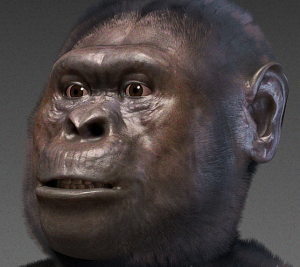
KYOTO UNIVERSITY—New fossils from Kenya suggest that an early hominid species— Australopithecus afarensis—lived far eastward beyond the Great Rift Valley and much farther than previously thought. An international team of paleontologists led by Emma Mbua of Mount Kenya University and Masato Nakatsukasa of Kyoto University report findings of fossilized teeth and forearm bone from an adult male and two infant A. afarensis from an exposure eroded by the Kantis River in Ongata-Rongai, a settlement in the outskirts of Nairobi.
“So far, all other A. afarensis fossils had been identified from the center of the Rift Valley,” explains Nakatsukasa. “A previous Australopithecus bahrelghazali discovery in Chad confirmed that our hominid ancestor’s distribution covered central Africa, but this was the first time an Australopithecus fossil has been found east of the Rift Valley. This has important implications for what we understand about our ancestor’s distribution range, namely that Australopithecus could have covered a much greater area by this age.”
A. afarensis is believed to have lived 3,700,000-3,000,000 years ago, as characterized by fossils like “Lucy” from Ethiopia.
____________________________________________
Above: A forensic facial reconstruction of A. afarensis based on fossil evidence. Cicero Moraes, Wikimedia Commons
___________________________________________________________
Stable isotope analysis revealed that the Kantis region was humid, but had a plain-like environment with fewer trees compared to other sites in the Great Rift Valley where A. afaransis fossils had previously appeared. “The hominid must have discovered suitable habitats in the Kenyan highlands. It seems that A. afaransis was good at adapting to varying environments,” notes Nakatsukasa.
The team’s survey also turned up masses of mammal fossils, including a few that probably belong to new species of bovids or baboons.
The authors write that the Kantis site was first noted in a 1991 geological survey. At that time, a farmer said that he and his family had come across fossilized bones from Kantis in the 1970s, although they did not recognize their importance. Following airing of Kenyan television programs on paleontological research, locals gradually started to appreciate the fossils. Since then, Kantis and other sites have been identified thanks to fossil notifications from the local population.
The team welcomes this achievement not only for its academic implications, but also for the benefits to the local community. “Kantis is in the vicinity of Nairobi, a major city,” said Nakatsukasa. “We hope that the discovery of the new site and the fossils will aid in increasing tourism, and in improving educational awareness of the local community.”
Source: Kyoto University news release.
__________________________________________________________
The paper “Kantis: A new Australopithecus site on the shoulders of the Rift Valley near Nairobi, Kenya” will appear May 2016 in the Journal of Human Evolution, with doi: 10.1016/j.jhevol.2016.01.006
__________________________________________________________

______________________________________________
Travel and learn with Far Horizons.
____________________________________________
This richly illustrated issue includes the following stories: Recent findings shedding new light on the whereabouts of the remains of Philip of Macedon, father of Alexander the Great; how an archaeologist-sculptor is bringing bones of the dead back to life; archaeologists uncovering town life at the dawn of civilization; an exclusive interview with internationally acclaimed archaeologist James M. Adovasio about what makes the Meadowcroft Rockshelter prominent in the ongoing search for the first Americans; what archaeologists are finding at the site of the ancient city of Gath, the home town of the biblical Philistine giant, Goliath; and how scientists are redrawing the picture of human evolution in Europe. Find it on Amazon.com.







